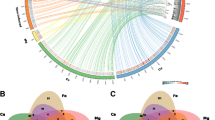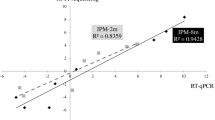Abstract
Isothiazolone biocides (such as Kathon) are widely used in a variety of industrial and domestic applications. However, the mechanisms through which bacteria develop resistance to these biocides are not completely clear. A better understanding of these mechanisms can contribute to optimal use of these biocides. In this study, transcription profiles of a Kathon-resistant strain of Pseudomonas aeruginosa (Pa-R) and the wild-type strain were determined using RNA sequencing (RNA-Seq) with the Illumina HiSeq 2000 platform. RNA-Seq generated 18,657,896 sequence reads aligned to 7093 genes. In all, 1550 differently expressed genes (DEGs, log2 ratio ≥1, false discovery rate (FDR) ≤0.001) were identified, of which 482 were up-regulated and 1068 were down-regulated. Most Kathon-induced genes were involved in metabolic and cellular processes. DEGs significantly enriched nitrogen metabolism and oxidative phosphorylation pathways. In addition, Pa-R showed cross-resistance to triclosan and ciprofloxacin and showed repressed pyocyanin production. These results may improve our understanding of the resistance mechanisms of P. aeruginosa against isothiazolones, and provide insight into the development of more efficient isothiazolones.








Similar content being viewed by others
References
Hancock RE (1998) Resistance mechanisms in Pseudomonas aeruginosa and other nonfermentative gram-negative bacteria. Clin Infect Dis 27:S93–S99
Lyczak JB, Cannon CL, Pier GB (2002) Lung infections associated with cystic fibrosis. Clin Microbiol Rev 15:194–222
Poole K (2011) Pseudomonas aeruginosa: resistance to the max. Front Microbiol 2:65
Morita Y, Tomida J, Kawamura Y (2014) Responses of Pseudomonas aeruginosa to antimicrobials. Front Microbiol 4:422
Lambert P (2002) Mechanisms of antibiotic resistance in Pseudomonas aeruginosa. J R Soc Med 95:22–26
Chapman JS (2003) Biocide resistance mechanisms. Int Biodeterior Biodegrad 51:133–138
Khalaj A, Adibpour N, Shahverdi AR, Daneshtalab M (2004) Synthesis and antibacterial activity of 2-(4-substituted phenyl)-3(2H)-isothiazolones. Eur J Med Chem 39:699–705
Pucci MJ, Podos SD, Thanassi JA, Leggio MJ, Bradbury BJ, Deshpande M (2011) In vitro and in vivo profiles of ACH-702, an isothiazoloquinolone, against bacterial pathogens. Antimicrob Agents Chemother 55:2860–2871
Vicentini CB, Romagnoli C, Manfredini S, Rossi D, Mares D (2011) Pyrazolo [3,4-c]isothiazole and isothiazolo [4,3-d]isoxazole derivatives as antifungal agents. Pharm Biol 49:545–552
Xu FL, Lin Q, Hou BR (2009) Synthesis and bioactivity of novel benzisothiazolone derivatives as potential microbiocides. J Heterocycl Chem 46:320–323
Collier PJ, Ramsey A, Waigh RD, Douglas KT, Austin P, Gilbert P (1990) Chemical reactivity of some isothiazolone biocides. J Appl Microbiol 69:578–584
Williams TM (2007) The mechanism of action of isothiazolone biocide. Power Plant Chem 9:14–22
Collier PJ, Austin P, Gilbert P (1991) Isothiazolone biocides: enzyme-inhibiting pro-drugs. Int J Pharm 74:195–201
Stimson L, Rowlands MG, Newbatt YM, Smith NF, Raynaud FI, Rogers P, Bavetsias V, Gorsuch S, Jarman M, Bannister A, Kouzarides T, McDonald E, Workman P, Aherne GW (2005) Isothiazolones as inhibitors of PCAF and p300 histone acetyltransferase activity. Mol Cancer Ther 4:1521–1532
Dekker FJ, Ghizzoni M, van der Meer N, Wisastra R, Haisma HJ (2009) Inhibition of the PCAF histone acetyl transferase and cell proliferation by isothiazolones. Bioorg Med Chem 17:460–466
Furdas SD, Shekfeh S, Bissinger E-M, Wagner JM, Schlimme S, Valkov V, Hendzel M, Jung M, Sippl W (2011) Synthesis and biological testing of novel pyridoisothiazolones as histone acetyltransferase inhibitors. Bioorg Med Chem 19:3678–3689
El Abdellaoui H, Varaprasad CVNS, Barawkar D, Chakravarty S, Maderna A, Tam R, Chen HM, Allan M, Wu JZ, Appleby T, Yan SQ, Zhang WJ, Lang S, Yao NH, Hamatake R, Hong Z (2006) Identification of isothiazole-4-carboxamidines derivatives as a novel class of allosteric MEK1 inhibitors. Bioorg Med Chem Lett 16:5561–5566
Lippa B, Morris J, Corbett M, Kwan TA, Noe MC, Snow SL, Gant TG, Mangiaracina M, Coffey HA, Foster B, Knauth EA, Wessel MD (2006) Discovery of novel isothiazole inhibitors of the TrkA kinase: structure-activity relationship, computer modeling, optimization, and identification of highly potent antagonists. Bioorg Med Chem Lett 16:3444–3448
Reddy BM, Tanneeru K, Meetei PA, Guruprasad L (2011) 3D-QSAR and molecular docking studies on substituted isothiazole analogs as inhibitors against MEK-1 kinase. Chem Biol Drug Des 79:84–91
Cheng JJ, Thanassi JA, Thoma CL, Bradbury BJ, Deshpande M, Pucci MJ (2007) Dual targeting of DNA gyrase and topoisomerase IV: target interactions of heteroaryl isothiazolones in Staphylococcus aureus. Antimicrob Agents Chemother 51:2445–2453
King A, Lodola A, Carmi C, Fu J, Mor M, Piomelli D (2009) A critical cysteine residue in monoacylglycerol lipase is targeted by a new class of isothiazolinone-based enzyme inhibitors. Br J Pharmacol 157:974–983
Yan SQ, Appleby T, Gunic E, Shim JH, Tasu T, Kim H, Rong F, Chen HM, Hamatake R, Wu JZ, Hong Z, Yao NH (2007) Isothiazoles as active-site inhibitors of HCVNS5B polymerase. Bioorg Med Chem Lett 17:28–33
Gedi V, Moon JY, Lim WM, Lee MY, Lee SC, Koo BS, Govindwar S, Yoon MY (2011) Identification and characterization of inhibitors of Haemophilus influenzae acetohydroxyacid synthase. Enzyme Microb Technol 49:1–5
Brözel VS, Cloete TE (1994) Resistance of Pseudomonas aeruginosa to isothiazolone. J Appl Bacteriol 76:576–582
Chen Y-C, Xie X-B, Shi Q-S, Ouyang Y-S, Chen Y-B (2010) Species identification of industry spoilage microorganism and the resistance analysis. Microbiol China 37:1558–1565
Zhou G, Shi Q, Huang X, Xie X, Chen Y (2015) Insights into Pseudomonas aeruginosa ATCC9027 resistance to isothiazolones through proteomics. Microb Drug Resist 21:140–148
Croucher NJ, Thomson NR (2010) Studying bacterial transcriptomes using RNA-seq. Curr Opin Microbiol 13:619–624
Pinto A, Melo-Barbosa H, Miyoshi A, Silva A, Azevedo V (2011) Application of RNA-seq to reveal the transcript profile in bacteria. Genet Mol Res 10:1707–1718
Howard-Flanders P, Theriot L (1966) Mutants of Escherichia coli K-12 defective in DNA repair and in genetic recombination. Genetics 53:1137–1150
Zhou G, Shi Q, Ouyang Y, Chen Y (2014) Involvement of outer membrane proteins and peroxide-sensor genes in Burkholderia cepacia resistance to isothiazolone. World J Microbiol Biotechnol 30:1251–1260
Chapman JS, Diehl MA (1995) Methylchloroisothiazolone-induced growth inhibition and lethality in Escherichia coli. J Appl Microbiol 78:134–141
Cock PJ, Fields CJ, Goto N, Heuer ML, Rice PM (2010) The Sanger FASTQ file format for sequences with quality scores, and the Solexa/Illumina FASTQ variants. Nucleic Acids Res 38:1767–1771
Grabherr MG, Haas BJ, Yassour M, Levin JZ, Thompson DA, Amit I, Adiconis X, Fan L, Raychowdhury R, Zeng Q (2011) Full-length transcriptome assembly from RNA-Seq data without a reference genome. Nat Biotechnol 29:644–652
Iseli C, Jongeneel CV, Bucher P (1999) ESTScan: a program for detecting, evaluating, and reconstructing potential coding regions in EST sequences. In: Proceedings of the 8th International Conference on Intelligent Systems for Molecular Biology, pp 138–148
Mortazavi A, Williams BA, McCue K, Schaeffer L, Wold B (2008) Mapping and quantifying mammalian transcriptomes by RNA-Seq. Nat Methods 5:621–628
Anders S, Huber W (2010) Differential expression analysis for sequence count data. Genome Biol 11:R106
Conesa A, Gotz S, Garcia-Gomez JM, Terol J, Talon M, Robles M (2005) Blast2GO: a universal tool for annotation, visualization and analysis in functional genomics research. Bioinformatics 21:3674–3676
Ye J, Fang L, Zheng H, Zhang Y, Chen J, Zhang Z, Wang J, Li S, Li R, Bolund L (2006) WEGO: a web tool for plotting GO annotations. Nucleic Acids Res 34:W293–W297
Boyle EI, Weng S, Gollub J, Jin H, Botstein D, Cherry JM, Sherlock G (2004) GO:TermFinder–open source software for accessing Gene Ontology information and finding significantly enriched Gene Ontology terms associated with a list of genes. Bioinformatics 20:3710–3715
Livak KJ, Schmittgen TD (2001) Analysis of relative gene expression data using real-time quantitative PCR and the 2−ΔΔCt method. Methods 25:402–408
Essar D, Eberly L, Hadero A, Crawford I (1990) Identification and characterization of genes for a second anthranilate synthase in Pseudomonas aeruginosa: interchangeability of the two anthranilate synthases and evolutionary implications. J Bacteriol 172:884–900
Audic S, Claverie JM (1997) The significance of digital gene expression profiles. Genome Res 7:986–995
Chapman JS, Diehl MA, Fearnside KB (1998) Preservative tolerance and resistance. Int J Cosmet Sci 20:31–39
Gusarov I, Shatalin K, Starodubtseva M, Nudler E (2009) Endogenous nitric oxide protects bacteria against a wide spectrum of antibiotics. Science 325:1380–1384
McCollister BD, Hoffman M, Husain M, Vázquez-Torres A (2011) Nitric oxide protects bacteria from aminoglycosides by blocking the energy-dependent phases of drug uptake. Antimicrob Agents Chemother 55:2189–2196
Dadi PK, Ahmad M, Ahmad Z (2009) Inhibition of ATPase activity of Escherichia coli ATP synthase by polyphenols. Int J Biol Macromol 45:72–79
Dairaku N, Kato K, Honda K, Koike T, Iijima K, Imatani A, Sekine H, Ohara S, Matsui H, Shimosegawa T (2004) Oligomycin and antimycin A prevent nitric oxide-induced apoptosis by blocking cytochrome C leakage. J Lab Clin Med 143:143–151
Potter VR, Reif AE (1952) Inhibition of an electron transport component by antimycin A. J Biol Chem 194:287–297
Chuanchuen R, Karkhoff-Schweizer RR, Schweizer HP (2003) High-level triclosan resistance in Pseudomonas aeruginosa is solely a result of efflux. Am J Infect Control 31:124–127
Mima T, Joshi S, Gomez-Escalada M, Schweizer HP (2007) Identification and characterization of TriABC-OpmH, a triclosan efflux pump of Pseudomonas aeruginosa requiring two membrane fusion proteins. J Bacteriol 189:7600–7609
Heath RJ, Rubin JR, Holland DR, Zhang E, Snow ME, Rock CO (1999) Mechanism of triclosan inhibition of bacterial fatty acid synthesis. J Biol Chem 274:11110–11114
Hoang TT, Schweizer HP (1999) Characterization of Pseudomonas aeruginosa enoyl-acyl carrier protein reductase (FabI): a target for the antimicrobial triclosan and its role in acylated homoserine lactone synthesis. J Bacteriol 181:5489–5497
Zhu L, Lin J, Ma J, Cronan JE, Wang H (2010) Triclosan resistance of Pseudomonas aeruginosa PAO1 is due to FabV, a triclosan-resistant enoyl-acyl carrier protein reductase. Antimicrob Agents Chemother 54:689–698
Chuanchuen R, Beinlich K, Hoang TT, Becher A, Karkhoff-Schweizer RR, Schweizer HP (2001) Cross-Resistance between triclosan and antibiotics in Pseudomonas aeruginosa is mediated by multidrug efflux pumps: exposure of a susceptible mutant strain to triclosan selects nfxB mutants overexpressing MexCD-OprJ. Antimicrob Agents Chemother 45:428–432
Fukuda H, Hosaka M, Hirai K, Iyobe S (1990) New norfloxacin resistance gene in Pseudomonas aeruginosa PAO. Antimicrob Agents Chemother 34:1757–1761
Kohler T, Michea-Hamzehpour M, Henze U, Gotoh N, Curty LK, Pechere JC (1997) Characterization of MexE-MexF-OprN, a positively regulated multidrug efflux system of Pseudomonas aeruginosa. Mol Microbiol 23:345–354
Li X-Z, Poole K, Nikaido H (2003) Contributions of MexAB-OprM and an EmrE homolog to intrinsic resistance of Pseudomonas aeruginosa to aminoglycosides and dyes. Antimicrob Agents Chemother 47:27–33
Sobel ML, Neshat S, Poole K (2005) Mutations in PA2491 (mexS) promote MexT-dependent mexEF-oprN expression and multidrug resistance in a clinical strain of Pseudomonas aeruginosa. J Bacteriol 187:1246–1253
Morita Y, Tomida J, Kawamura Y (2015) Efflux-mediated fluoroquinolone resistance in the multidrug-resistant Pseudomonas aeruginosa clinical isolate PA7: identification of a novel MexS variant involved in upregulation of the mexEF-oprN multidrug efflux operon. Front Microbiol 6:8
Hassett DJ, Charniga L, Bean K, Ohman DE, Cohen MS (1992) Response of Pseudomonas aeruginosa to pyocyanin: mechanisms of resistance, antioxidant defenses, and demonstration of a manganese-cofactored superoxide dismutase. Infect Immun 60:328–336
Mavrodi DV, Bonsall RF, Delaney SM, Soule MJ, Phillips G, Thomashow LS (2001) Functional analysis of genes for biosynthesis of pyocyanin and phenazine-1-carboxamide from Pseudomonas aeruginosa PAO1. J Bacteriol 183:6454–6465
Dietrich LEP, Price-Whelan A, Petersen A, Whiteley M, Newman DK (2006) The phenazine pyocyanin is a terminal signalling factor in the quorum sensing network of Pseudomonas aeruginosa. Mol Microbiol 61:1308–1321
Muller M, Merrett ND (2014) Pyocyanin production by Pseudomonas aeruginosa confers resistance to ionic silver. Antimicrob Agents Chemother 58:5492–5499
Acknowledgments
Financial supports were provided by the National Natural Science Foundation of China (No. 31500036), Natural Science Foundation of Guangdong Province (No. 2015A030313713), Cooperation Projects of Foshan City and Chinese Academy (No. 2012HY100115) and Jieyang Cooperation Projects of Industry-University-Research (No. 201429).
Author information
Authors and Affiliations
Corresponding author
Ethics declarations
Conflict of interest
The authors declare that they have no conflict of interests.
Electronic supplementary material
Below is the link to the electronic supplementary material.
Rights and permissions
About this article
Cite this article
Zhou, G., Shi, Qs., Huang, Xm. et al. Comparison of transcriptomes of wild-type and isothiazolone-resistant Pseudomonas aeruginosa by using RNA-seq. Mol Biol Rep 43, 527–540 (2016). https://doi.org/10.1007/s11033-016-3978-y
Received:
Accepted:
Published:
Issue Date:
DOI: https://doi.org/10.1007/s11033-016-3978-y




